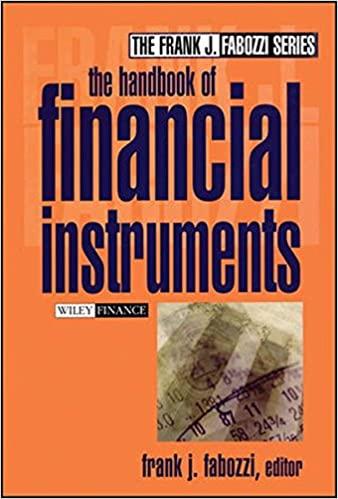Question
a. What are the key features of a bond? b. What are call provisions and sinking fund provisions? Do these provisions make bonds more or
a. What are the key features of a bond?
b. What are call provisions and sinking fund provisions? Do these provisions make bonds more or less risky?
c. How does one determine the value of any asset whose value is based on expected future cash flows? d. How is the value of a bond determined? What is the value of a 10-year, $1,000 par value bond with a 10% annual coupon if its required rate of return is 10%?
e.
(1) What would be the value of the bond described in part d if, just after it had been issued, the expected inflation rate rose by 3 percentage points, causing investors to require a 13% return? Would we now have a discount or a premium bond?
(2) What would happen to the bond's value if inflation fell and rd declined to 7%? Would we now have a premium or a discount bond?
(3) What would happen to the value of the 10-year bond over time if the required rate of return remained at 13%? If it remained at 7%? (Hint: With a financial calculator, enter PMT, I/YR, FV, and N, and then change N to see what happens to the PV as the bond approaches maturity.)
f.
(1) What is the yield to maturity on a 10-year, 9% annual coupon, $1,000 par value bond that sells for $887.00? That sells for $1,134.20? What does the fact that a bond sells at a discount or at a premium tell you about the relationship between rd and the bond's coupon rate?
(2) What are the total return, the current yield, and the capital gains yield for the discount bond? (Assume the bond is held to maturity and the company does not default on the bond.)
g. How does the equation for valuing a bond change if semiannual payments are made? Find the value of a 10-year, semiannual payment, 10% coupon bond if the nominal rd = 13%. h. Suppose a 10-year, 10% semiannual coupon bond with a par value of $1,000 is currently selling for $1,135.90, producing a nominal yield to maturity of 8%. However, the bond can be called after 5 years for a price of $1,050.
(1) What is the bond's nominal yield to call (YTC)?
(2) If you bought this bond, do you think you would be more likely to earn the YTM or the YTC? Why?
i. Write a general expression for the yield on any debt security (rd) and define these terms: real risk-free rate of interest (r*), inflation premium (IP), default risk premium (DRP), liquidity premium (LP), and maturity risk premium (MRP).
j. Define the nominal risk-free rate (rRF). What security can be used as an estimate of rRF
k. Describe a way to estimate the inflation premium (IP) for a t-year bond.
l. What is a bond spread and how is it related to the default risk premium? How are bond ratings related to default risk? What factors affect a company's bond rating?
m. What is interest rate (or price) risk? Which bond has more interest rate risk: an annual payment 1-year bond or a 10-year bond? Why?
n. What is reinvestment rate risk? Which has more reinvestment rate risk: a 1-year bond or a 10-year bond?
o. How are interest rate risk and reinvestment rate risk related to the maturity risk premium?
p. What is the term structure of interest rates? What is a yield curve?
q. Briefly describe bankruptcy law. If a firm were to default on its bonds, would the company be liquidated immediately? Would the bondholders be assured of receiving all of their promised
Step by Step Solution
There are 3 Steps involved in it
Step: 1

Get Instant Access to Expert-Tailored Solutions
See step-by-step solutions with expert insights and AI powered tools for academic success
Step: 2

Step: 3

Ace Your Homework with AI
Get the answers you need in no time with our AI-driven, step-by-step assistance
Get Started


